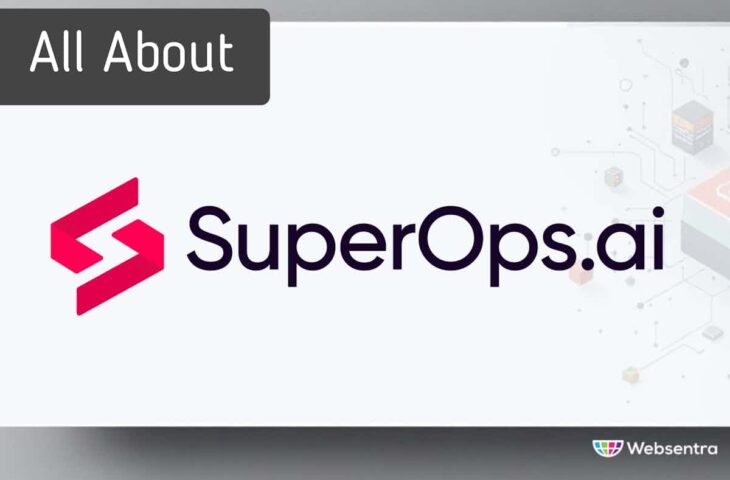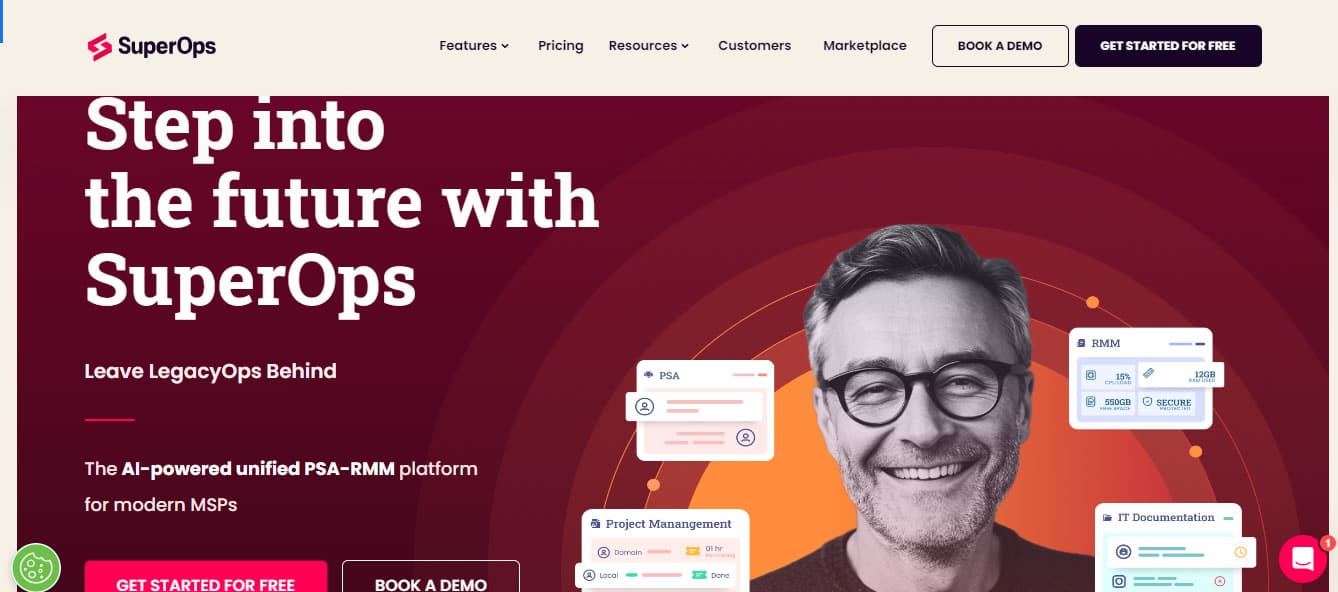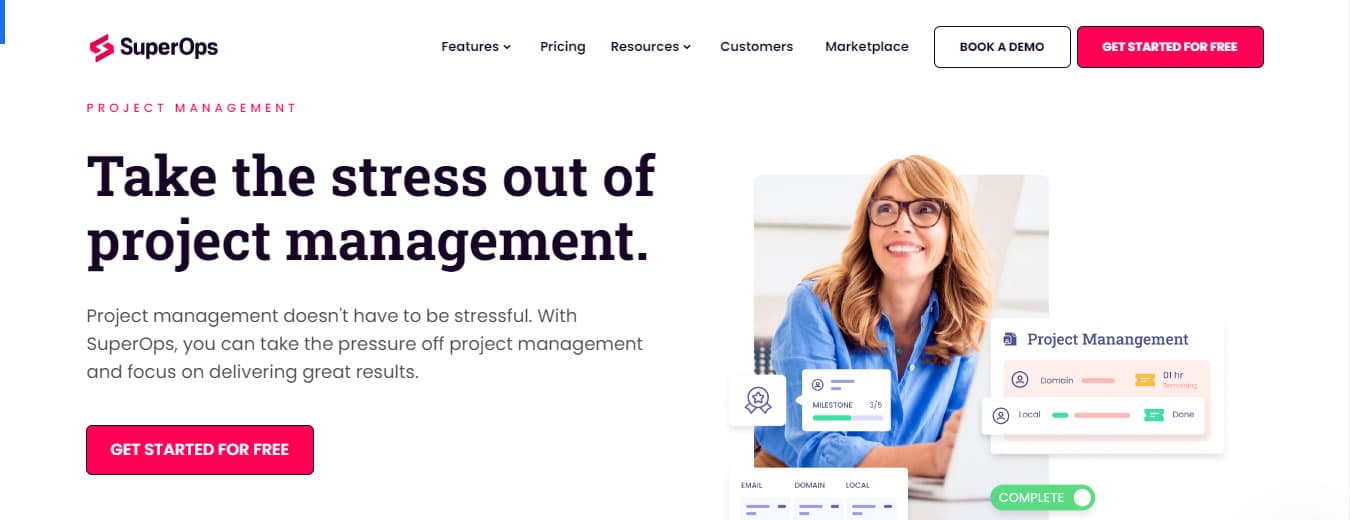We may earn a commission if you make a purchase through the links on our website.
All About SuperOps

UPDATED: November 1, 2024
In the rapidly evolving field of IT management and service delivery, tools that automate operations and enhance productivity are invaluable. One such tool making waves in the managed service provider (MSP) community is SuperOps. This innovative platform aims to simplify and optimize the workflows of IT teams, enabling them to focus on delivering exceptional service to their clients.
In this article, we will discuss SuperOps’s origins, timeline of key events and milestones, resilience in overcoming challenges, product evolution, and key product offerings. This provides a detailed overview of SuperOps and its contributions in the domain of Professional Services Automation (PSA), and Remote Monitoring and Management (RMM).
The Founding of SuperOps: A New Era for MSPs
Founders and Their Vision: SuperOps was founded by Arvind Parthiban and Jayakumar Karumbasalam, two visionaries who recognized the need for innovation in the managed service provider (MSP) sector. Both founders started their careers in the tech industry as newcomers, building MSP software that laid the groundwork for their future endeavors. After years of experience and observing the evolution of technology, they noticed a stark contrast: while many industries advanced rapidly, software tailored for MSPs lagged significantly, often remaining mired in outdated, on-premise solutions.
The duo was determined to change this narrative. In 2020, as the world grappled with the ramifications of the pandemic, leading to a surge in remote work and distributed teams, Arvind and Jayakumar seized the opportunity to create a platform that would empower MSPs to thrive. They envisioned a solution that not only modernized service delivery but also incorporated AI-powered tools for network monitoring, IT documentation, and project management—all within a unified PSA-RMM framework.
The Birth of SuperOps: With a clear mission in mind, Arvind and Jayakumar established SuperOps in 2020. Their goal was to develop a best-in-class software solution that MSPs truly deserve, one that could transform their operations and rejuvenate their work culture. They assembled a passionate team of engineers, product architects, designers, and AI and ML experts, collectively boasting over five decades of experience in building IT Service Management (ITSM) and IT Operations Management (ITOM) products.
The foundation of SuperOps was built on the belief that MSPs are critical partners in the technology ecosystem and deserve the best tools available. This commitment to understanding and addressing the unique challenges faced by MSPs would become a cornerstone of the company's philosophy.
Timeline of Key Events and Milestones
2020 – Founding Year
- August 2020: SuperOps is founded by Arvind Parthiban and Jayakumar Karumbasalam. The company also secures seed funding to kickstart its mission.
- April 2021: The beta version of the SuperOps platform is released for testing with select MSP partners.
- July 2021: SuperOps acquires its first paying customer, marking a significant milestone in its growth.
2021 – Product Launch and Growth
- January 2022: SuperOps officially exits beta, launching its platform publicly and securing Series A funding to fuel further development and expansion.
2022 – Recognition and Expansion
- September 2022: The company successfully raises Series B funding, providing additional resources for product enhancements and market expansion.
- October 2022: SuperOps launches its Network Monitoring feature, further expanding its capabilities within the unified PSA-RMM platform.
2023 – Continued Innovation and Customer Focus
- Ongoing 2023: SuperOps focuses on continuous improvement, introducing advanced AI features and refining the user experience based on customer feedback.
This timeline highlights the significant milestones in SuperOps' journey, reflecting its rapid growth and commitment to empowering MSPs with cutting-edge technology.
Evolution of SuperOps Product Suite
SuperOps' product suite has evolved significantly in response to advancements in network technologies and changing industry needs. Key aspects of this evolution include:
- Integration of AI and Automation: As AI technology advanced, SuperOps incorporated AI-driven features to enhance automation in ticketing, monitoring, and documentation. This allowed MSPs to streamline their workflows and reduce manual effort.
- Cloud-Based Solutions: With the rise of cloud computing, SuperOps cloud-based strategy provides MSPs with greater flexibility, scalability, and accessibility. This approach allowed users to manage operations from anywhere, a crucial need in today’s remote work environment.
- Enhanced Security Features: As cybersecurity threats have become more prevalent, SuperOps has continuously updated its RMM and IT documentation capabilities to include advanced security measures. This includes automated patch management and real-time threat detection, ensuring MSPs can safeguard their clients’ networks effectively.
- Interoperability and Integrations: Recognizing the importance of seamless workflows, SuperOps has prioritized interoperability with other tools and platforms. This allows MSPs to integrate their existing systems with SuperOps, providing a more cohesive operational experience.
- User Experience Improvements: With advancements in user interface design and user experience principles, SuperOps has continually refined its platform to make it more intuitive and user-friendly. Regular updates based on user feedback ensure that the product suite meets evolving expectations.
The hallmark of SuperOps' product suite is its unified platform, which integrates multiple products/functionalities designed specifically for MSPs. This holistic approach allows MSPs to manage all aspects of their operations from a single interface. These products/functionalities are described as follows;
- Professional Services Automation (PSA): The PSA module was one of the foundational elements of SuperOps. Recognizing the need for MSPs to manage client interactions, service requests, and billing processes efficiently, SuperOps set out to create a comprehensive PSA solution. This included functionalities such as ticketing systems, client management, time tracking, and invoicing. Over time, SuperOps expanded its PSA capabilities to include automation features that reduce manual entry and enhance operational efficiency. Integration with other tools and platforms has also been a focus, allowing for seamless workflows and data sharing across different systems.
- Remote Monitoring and Management (RMM): Understanding the importance of proactive monitoring in IT management, SuperOps developed its RMM capabilities to provide real-time insights into network performance and system health. This was crucial for MSPs aiming to prevent issues before they escalated into significant problems. The RMM capabilities have continuously evolved, incorporating AI-driven analytics to enhance predictive maintenance. This helps MSPs anticipate potential issues and act proactively, rather than reactively, thereby reducing downtime and improving service reliability.
- IT Documentation: Recognizing that proper documentation is vital for effective IT management, SuperOps introduced a robust IT documentation module. This component enables MSPs to maintain comprehensive records of their IT environments, including configurations, processes, and client-specific information. SuperOps has enhanced its IT documentation capabilities by integrating automation features that facilitate the documentation process. This includes auto-generating documentation based on system configurations and changes, allowing MSPs to keep their records up to date without significant manual effort.
- Project Management: To address the need for effective project management within MSP operations, SuperOps developed its project management capabilities. This module allows teams to plan, execute, and monitor projects from initiation to completion. The project management capabilities have evolved to include integration with other modules, such as PSA and RMM. This integration allows MSPs to align project management with service delivery, ensuring that projects are completed on time and within budget.
Challenges and How They Were Addressed
Throughout its journey, SuperOps encountered various challenges that tested its resilience and competitiveness. The company’s ability to navigate these hurdles has played a crucial role in establishing its success and reputation within the industry. Here’s an in-depth look at the key challenges faced by SuperOps and the innovative strategies employed to overcome them.
1. Market Competition: The MSP software market is highly competitive, with established players and new entrants vying for market share. SuperOps needed to differentiate itself in a crowded landscape, where many offerings were entrenched in outdated models. This was addressed in the following ways:
- Unique Value Proposition: SuperOps emphasized its AI-powered unified PSA-RMM platform as a key differentiator. By highlighting features like integrated network monitoring and IT documentation, the company positioned itself as a modern solution tailored for today’s MSP needs.
- Customer-Centric Development: Engaging directly with MSPs to gather feedback allowed SuperOps to refine its features based on real-world requirements, ensuring that the product suite resonated with user expectations.
2. Product Development Complexity: Building a comprehensive platform that integrates multiple functionalities—PSA, RMM, IT documentation, and project management—presented significant technical challenges. Ensuring seamless interoperability among these components required careful planning and execution. This was achieved using the following methodologies:
- Agile Methodology: SuperOps adopted agile development practices, enabling iterative progress and continuous improvement. This approach allowed teams to pivot based on feedback and adapt to changing requirements quickly.
- Modular Architecture: The development of a modular architecture facilitated the integration of various features. This not only made the development process more manageable but also allowed for easier updates and enhancements in response to user needs.
3. Adoption and User Training: Transitioning MSPs from outdated systems to a modern platform often involves resistance due to the fear of change, as well as the need for adequate training to ensure smooth adoption. Here’s how SuperOps did it:
- Robust Onboarding Program: SuperOps developed a robust onboarding program that includes training sessions, documentation, and resources designed to help new users acclimate to the platform quickly.
- Dedicated Customer Support: The establishment of a dedicated customer support team ensured that MSPs had access to assistance whenever needed. This proactive approach alleviated concerns and fostered a positive user experience.
4. Scaling Operations: Rapid growth brought its own set of challenges, including the need for scalable infrastructure and a workforce capable of supporting an expanding user base. Maintaining service quality while scaling operations was critical. Here’s how it was tackled:
- Investment in Infrastructure: SuperOps invested in cloud-based solutions and scalable infrastructure, ensuring that the platform could handle increased demand without compromising performance.
- Strategic Hiring: The company focused on hiring experienced professionals across engineering, customer support, and sales to build a strong team capable of managing growth while maintaining service quality.
5. Maintaining Innovation: In a fast-paced tech environment, staying ahead of trends and continuously innovating is essential for long-term success. SuperOps faced the challenge of keeping its platform relevant and cutting-edge. Here’s how it was overcome:
- Continuous Feedback Loop: Establishing a continuous feedback loop with users helped identify areas for improvement and innovation. Regular surveys and user interviews ensured that the product roadmap aligned with user needs.
- Investment in R&D: SuperOps dedicated resources to research and development, focusing on integrating emerging technologies like artificial intelligence and machine learning to enhance platform capabilities.
6. Building Brand Awareness: As a relatively new player in the market, SuperOps needed to build brand recognition and trust among potential customers who were already accustomed to established solutions. This was accomplished in the following ways:
- Marketing and Outreach: SuperOps implemented targeted marketing campaigns that showcased its unique features and benefits, emphasizing case studies and success stories from early adopters.
- Community Engagement: Engaging with the MSP community through webinars, conferences, and industry events helped build credibility and establish SuperOps as a thought leader in the space.
Indeed, SuperOps' journey has been marked by challenges typical of a startup in a competitive tech landscape. Through strategic planning, a commitment to innovation, and a customer-centric approach, the company successfully navigated these obstacles. As it continues to evolve, SuperOps seems determined to provide MSPs with the tools they need to succeed in an ever-changing tech landscape.
Flagship Product: SuperOps PSA-RMM Platform

SuperOps is a cutting-edge, all-in-one PSA-RMM platform designed for forward-thinking MSPs. The SuperOps PSA-RMM platform represents a significant leap forward for modern MSPs, enabling them to operate more efficiently while delivering top-notch IT support services. What makes SuperOps stand out in the crowded MSP solutions market is its powerful integration of PSA and RMM into a single, AI-driven platform. This unified approach not only enhances operational capabilities but also allows for proactive management of client needs.
Key Features:
- Asset Management: SuperOps provides total control over clients' asset networks, offering complete visibility and accuracy across multiple endpoints.
- Patch Management: The platform automates patch management, allowing users to prioritize, filter, sort, and schedule updates effortlessly.
- Desktop Management: SuperOps includes remote background tools such as the Terminal, Remote File Explorer, and Windows Registry Editor, enabling technicians to diagnose and resolve issues efficiently.
- Policy Management: Set up policy groups to monitor all client assets and save time, effort, and money with SuperOps policy management and automated patching.
- Service Desk: Empower technicians to communicate with clients better, manage them with ease, and drive profitability with extensive insights into the state of your operations.
- Contract Management: Set up easy, flexible contracts in minutes to simplify your invoicing and to bill clients accurately.
- Calendar-First Scheduling: This feature focuses on integrating scheduling with a calendar, potentially making it easier to manage appointments and deadlines.
- Smart Tracker: Easily track time from any web or mobile device, and quickly identify and address inefficiencies with live timesheets.
- Reports and Analytics: Leverage dashboards to generate dynamic reports, monitor KPIs, and obtain critical insights to drive your business growth.
SuperOps is well-suited for mid-sized to large MSPs looking to modernize their operations and provide exceptional IT support services across diverse industries. Companies that prioritize efficiency, proactive service delivery, and scalability will find SuperOps to be an ideal fit. Additionally, MSPs aiming to enhance client satisfaction and operational performance will benefit greatly from the platform's AI-driven insights and integrated tools, allowing them to adapt to the evolving demands of the IT landscape. A free 14-day trial is available on request.
Pros:
- Proactive Issue Prevention: Minimizes downtime by identifying and addressing potential issues before they escalate.
- Intelligent Alerts: AI-driven notifications filter out unnecessary noise, allowing teams to focus on critical alerts that matter.
- AI Ticket Summarization: The inclusion of AI-driven ticket summarization can help quickly understand and prioritize support tickets, improving response times and efficiency.
- Efficient Endpoint Management: Automated processes streamline the management of endpoints, making operations more effective.
- Fast Support: Provides quick assistance through a single, centralized dashboard that consolidates all necessary tools and information.
- Enhanced Automation: Simplifies repetitive tasks, boosting overall efficiency and freeing up time for more strategic work.
- Operational Visibility: Offers a comprehensive view of operations, helping identify areas for optimization and increasing profitability.
Cons:
- Learning Curve for New Users: While the platform is user-friendly, new users may initially face a learning curve as they familiarize themselves with the extensive features and functionalities.
- Reliance on Internet Connectivity: As a cloud-based solution, SuperOps requires a stable internet connection, which may pose challenges in areas with unreliable service.
- AI Limitations: While intelligent alerts are beneficial, there may be instances where AI misinterprets data, leading to missed or unnecessary alerts.
Notable Module: SuperOps Project Management

SuperOps' project management module is designed to alleviate the stress often associated with managing projects. It is designed to simplify the project management process, allowing teams to focus on delivering results. With its focus on centralized information sharing, enhanced communication, visual planning, and efficient file sharing, teams can collaborate more effectively and achieve their goals with greater ease.
Key Features:
- Centralized Information Hub: Provides a single location for sharing and storing project-related information, ensuring all team members have access to the same resources.
- Task Comments and Communication: Enables team members to comment on tasks, facilitating real-time communication about progress, roadblocks, and questions.
- Visual Project Planning: Allows users to create project plans that visualize timelines, key milestones, and deliverables, helping teams track progress effectively.
- Collaboration Tools: Organizes work into projects, making it easy for teams to see how their tasks contribute to overall goals and encouraging collaboration.
- Context-Rich File Sharing: Facilitates easy sharing of files within the project module, reducing the risk of lost files and ensuring that all relevant documents are accessible.
SuperOps project management tool stands out from others primarily due to its integration of project management functionalities with PSA and RMM. This unique combination allows teams to manage their projects in the context of broader IT operations, fostering a holistic approach to service delivery. SuperOps is ideal for MSPs and IT teams that manage complex projects involving multiple stakeholders and deliverables.
Pros:
- Improved Communication: The task comment feature promotes transparency and clarity, reducing misunderstandings among team members.
- Enhanced Organization: Centralized information and visual project planning help teams stay organized and focused on their objectives.
- Streamlined Collaboration: By clearly defining roles and responsibilities within projects, SuperOps encourages effective teamwork and collaboration.
- Team Efficiency: Context-rich file sharing saves time and minimizes the hassle of searching for documents, allowing teams to work more efficiently.
- Flexibility: The tool is adaptable for various project types and sizes, making it suitable for different teams and industries.
Cons:
- Limited Customization: Some users may find that the tool lacks extensive customization options for specific project management methodologies or workflows.
- Dependence on Connectivity: As a cloud-based tool, reliable internet access is essential; disruptions in connectivity can hinder project progress.
Wrap-Up
SuperOps has become a game changer in the MSP solutions market, offering a unique suite of tools designed to enhance efficiency, collaboration, and service delivery. From its powerful AI-driven PSA-RMM platform that streamlines operations and minimizes downtime, to its intuitive IT documentation and project management tool that fosters clear communication and effective teamwork. It equips MSPs with the capabilities they need to excel in a competitive environment.
Throughout this article, we've explored the company’s founding vision, key milestones, and the challenges it has overcome, highlighting how SuperOps stands apart from its competitors with its unique integration of services and user-centric design. As SuperOps continues to innovate and expand its offerings, it remains committed to supporting MSPs in navigating the evolving IT landscape, ultimately shaping the future of IT service management.